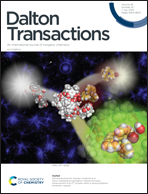Probing the non-innocent nature of an amino-functionalised β-diketiminate ligand in silylene/iminosilane systems†
Abstract
Electron-rich β-diketiminate ligands, featuring amino groups at the backbone β positions (“N-nacnac” ligands) have been employed in the synthesis of a range of silylene (SiII) complexes of the type (N-nacnac)SiX (where X = H, Cl, N(SiMe3)2, P(SiMe3)2 and Si(SiMe3)3). A combination of experimental and quantum chemical approaches reveals (i) that in all cases rearrangement to give an aza-butadienyl SiIV imide featuring a contracted five-membered heterocycle is thermodynamically favourable (and experimentally viable); (ii) that the kinetic lability of systems of the type (N-nacnac)SiX varies markedly as a function of X, such that compounds of this type can be isolated under ambient conditions for X = Cl and P(SiMe3)2, but not for X = H, N(SiMe3)2 and Si(SiMe3)3; and (iii) that the ring contraction process is most facile for systems bearing strongly electron-donating and sterically less encumbered X groups, since these allow most ready access to a transition state accessed via intramolecular nucleophilic attack by the SiII centre at the β-carbon position of the N-nacnac ligand backbone.



 Please wait while we load your content...
Please wait while we load your content...